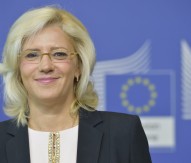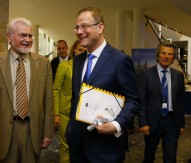
Analysis… Innovation outlook
With possible uphill financial struggles ahead, Portal sat down with EIT interim director Martin Kern to discuss the impact of the European Fund for Strategic Investments on the EU’s innovation body.
With 2015 marking the first year of the INNOVEIT conferences, European Institute of Innovation and Technology (EIT) interim director Martin Kern discussed the background of this new annual event with Portal in Budapest, Hungary. He set out the developments of the latest two KICs and the wide-ranging impact of the European Fund for Strategic Investments (EFSI) on the EIT.
How does it feel to finally bring together the elements of four key EIT events into a single, major conference?
We at the EIT are very pleased as the EIT Innovation Forum INNOVEIT gives an opportunity for EIT stakeholders to interact at very different levels, from the European Commission and EU member states to the EIT Governing Board and the KICs. This was a deliberate choice on our side in pulling together the different elements, namely the EIT Stakeholder Forum and member state configuration, the EIT Awards, the EIT Roundtables and EIT Alumni Connect.
It works really well considering the feedback we have received so far; it is very much in the EIT spirit to bring different people together, not only through the knowledge triangle but also beyond, to bring out new ideas and initiatives.

Martin Kern says he is pleased with the initial progress made by the new EIT Health and EIT Raw Materials KICs © European Institute of Innovation and Technology
How would you assess the progress made by the new EIT Health and Raw Materials KICs?
We moved very fast with their start-up phase, which is what we hoped for in December. They have put together concrete plans for the start-up period, and in the second half of this year, they will present their progress to the governing board and expect to become fully confirmed as KICs, meaning that they have successfully completed the start-up phase. The EIT has already awarded start-up grants to support them in this process, and they are now intensively working on the key benchmarks.
Both KICs are now recruiting a CEO and the wider management team, a very important process, as well as putting in place the legal structure to conclude the framework partnership agreement with us. The most curious, and most anticipated, aspect is the submission of their first business plan to the EIT in September, which will be assessed in terms of quality and will set a major milestone for the KIC.
To what extent have you suitably addressed the criticism regarding the setting up of new KICs?
We have learnt lessons in terms of speed and there are now many tools available for the two new KICs. For example, if we consider financial sustainability, we have developed a lot of experience and put principles in place of good governance, principles that the new KICs can immediately access and implement once an agreement is in place that helps to focus the minds.
The whole procedure and guidelines for business plans and annual grant agreements are much more developed now and there is a much more solid structure. This translates into things growing faster, getting quicker and focusing on the real activities and operations, rather than spending time only on setting up the structures and administration, which are absolutely needed nevertheless.
What is the background to initially limiting the number of co-location centres in the 2016 KICs?
We conducted a ‘big lessons learnt exercise’ after the 2014 KIC call. Whilst we think it went very well, there are always elements that can be improved. One area that is important is the need for competition in and among the KICs. We have realised that if you have a very large partnership in the start-up phase, it takes longer to get off the ground; there are also limited funds available for KICs at the start.
One of the conclusions therefore is to have less complexity at the beginning, meaning there is more focus and greater clarity on what KICs will set out to do. Later, they may grow in terms of the number of partners and their co-location centres, but at the beginning, it is good for focus and for competition to set these limitations.
We are working to have the next KIC call in 2016, when two more KICs will be created: one in the area of added value manufacturing and one in the area of food for the future. We plan to limit applications to 50 partners and five co-location centres at the proposal stage and believe this will help give a more focused proposal and increase the competition in the calls. We strive to have one more KIC in 2018 addressing urban mobility, although this depends on us having a positive midterm evaluation of the EIT.
What other action can the EIT take in order to meet societal challenges?
The EIT is undergoing a performance audit and we are very much monitoring our work and undertaking reviews in thematic areas, for example in the education field and business creation. We are developing a more comprehensive monitoring strategy, and soon there will be a review on innovation activities within the KICs.
We therefore believe the EIT already has a lot to feed into the work of Horizon 2020 in terms of lessons learnt and what is successful and effective in the EIT and KIC model, helping to shape the future design of work programmes and Horizon 2020.
Another important dimension is the linkages between the different Horizon 2020 objectives, which are part of this exercise. We can see how the different programmes are complementary and how they can feed into each other. We believe the EIT is one of the most important initiatives under Horizon 2020 and has lots to feed into the (specific thematic) research and innovation framework programmes; we really look forward to completing those review exercises over the next few years and getting the results.
To what extent has the new Commission welcomed the work of the EIT?
Whilst the commissioners are relatively new, the services remain. They were already quite familiar with the EIT, in terms of both horizontal services and also those that are linked to the specific KICs, for example DG Climate Action in the area of climate change.
We have great support from our own commissioner, under whose brief the EIT is placed. European Commissioner Tibor Navracsics has been very keen and committed to support the EIT from the beginning: he visited the EIT within a month of taking up office and has since given us really good support, so we are very pleased with that.
We also received a visit from European Commission Vice-President Jyrki Katainen as part of the presentations on the EFSI; he was also very interested and very supportive regarding the types of activities that are needed and supported by the EIT to generate innovation in Europe.
What impact will a €350m budget cut have on the EIT, as proposed by the EFSI?
If those plans are confirmed and there is a reduction of the EIT’s budget over the coming years, there will have to be a scaling down of KIC activities and a reduction of outputs and results from the EIT, which is unfortunate. Consequently, there might be fewer graduates, fewer new start-ups created, and fewer innovation and knowledge transfers produced.
If the plan is confirmed, the main budgetary impact for the EIT will be in the years 2016 and 2017. This presents a short term challenge for the EIT, and particularly the KICs, who have anticipated and made their plans from earlier budgets. There is now a dialogue with the Commission looking at what opportunities the Investment Plan for Europe can bring, and we want to explore how far KICs, or some of the portfolios of KIC activities, could also benefit from the Juncker plan.
We believe there is real complementarity between the EFSI and the EIT KICs in leveraging private sector investment, and there may also be possibilities for the KICs to participate; this is one area where there can be a positive outcome.
You obviously think very highly of the Commission, but is this a case of it saying one thing in private and doing another in public?
In a sense, it is fully understandable that if there is a new initiative coming from the Commission and there is no new budget available, there will have to be a reallocation of some existing budgets. Yet, if we can find a complementarity between the two instruments – what the EIT is doing and what the Juncker plan is seeking to achieve – then that can be beneficial. A very positive attribute of the Juncker plan is its objective to generate investment and growth, and that is exactly what Europe needs and what the EIT stands for.
What other steps can the Commission take to realise the knowledge triangle?
The EIT is in some ways unique. We have this long term view and a very specific funding model, where a KIC receives 25% of funding from the EIT and must then attract the rest of its funding from elsewhere. We fully integrate the so-called ‘knowledge triangle of business, higher education and research’ to boost innovation. If you consider all these elements, there aren’t really any instruments like the EIT which also bring the same added value and uniqueness.
But there are other instruments, such as public private partnerships and joint technology initiatives, which have related objectives, and there are a number of programmes to support enterprises. There are synergies and linkages with the EIT, and it is very important to look at them as a whole, because the overall policy objective is what matters and what we feed into.
What will the jury be looking for in its assessment of the nominees for the EIT Awards?
We are looking for something that is impressive and that has the most potential. If you look at the 2013 winners, for example of the EIT CHANGE Award, people with EIT-labelled degrees are taking their ideas further and really becoming change leaders. We very much hope that the winners will continue to grow, become big success stories, and bring significant societal impact.
Martin Kern
European Institute of Innovation and Technology
This article first appeared in the seventh edition of Horizon 2020 Projects: Portal, which is now available here.




